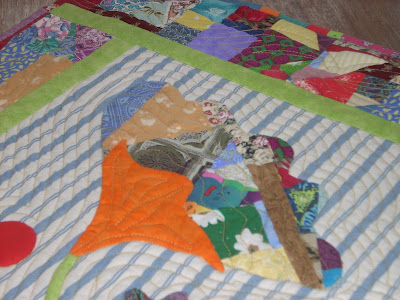En varias ocasiones me han comentado sobre mis trabajos acolchados y también me han preguntado de cómo lo hago. Un curso introductorio al patchwork, hace hincapié a las diferentes técnicas de costuras y tipos de bloques, acolchado a mano y fugazmente, algo a máquina. Salvo, si se realiza algún taller exclusivo al tema (acá no he visto nada de eso), todo el mundo concuerda que el acolchado a máquina se consigue con la práctica (o con máquinas especiales, por supuesto).
On several occasions I receive comments on my quilting and have asked me how I do. An introductory course in patchwork emphasizes the different stitching techniques and types of blocks, hand quilting and fleetingly, something quilting machine. Except, if you do something exclusive workshop about the item (here I have not seen anything like that), everyone agrees that the quilting machine is with practice (or with special machines, of course).
Inicialmente, me resultó difícil el acolchado a mano, era incapaz de traspasar con la aguja las tres capas, y si lo lograba, el bastidor me molestaba. Mi sampler, el que realicé cuando hice el curso, está guardado en la parte superior de un closet horrorosamente acolchado, algún día me daré el trabajo de desarmarlo. Nada de esto me desanimó, al contrario, busqué información por internet y en un par de libros que tengo, compré los pies adecuados para la máquina y empecé a practicar. Después de intentarlo con el pie libre, me decidí por usar plantillas de papel y coser por encima.
Preparo la máquina con el pie de acolchado recto (me dirán que no es el adecuado, pero también se consigue curvas suaves), bajo la tensión del hilo, aumento el largo de la puntada y personalmente uso la máquina con velocidad lenta.
Initially, I found it difficult to hand quilting, was unable to pass the needle three layers of sandwich, and if it succeeded, it bothered me the frame. My sampler, which I did when I did the course, is saved in the top of a closet horribly quilted; someday I'll work to disarm. None of this discouraged me, by contrast, I looked for information online and in a couple of books I have, I bought the foot for the machine and I started practicing. After trying with free foot, I decided to use paper templates and sew over.
I prepare the machine with the right foot pad (someone says it is not appropriate, but with it, I get smooth curves too), I reduce the thread tension, increase the stitch length and personally use the machine speed.
A continuación hay una secuencia del proceso, desde la colocación de la plantilla sobre el sandwich (tener cuidado que no queden alfileres debajo del papel), costura siguiendo el dibujo, retiro del papel suavemente para no alterar la costura.
Below is a sequence of the process, from placing the template on the sandwich (be careful that pins are not under the paper), sew following the drawing, removal of paper gently to avoid disturbing the seam.
Lo desagradable es cómo terminan esas plantillas que preparo una por una, pero hay un sitio donde está todo listo, y ahora vi otra manera de confeccionarlas, aún no la he probado.
Bueno, esa es la forma de acolchar con mi máquina casera, con práctica estoy consiguiendo trabajos que me dejan conforme, anímense ustedes también.
The ugliness is how to end these templates to prepare one by one, but there is a place where everything is ready, and now I saw another way to create it, yet I have not tested.
Well, that's the way to my home machine quilting, with practice I'm getting jobs that leave me satisfied, you can too.
Hasta pronto.
Goodbye.




























